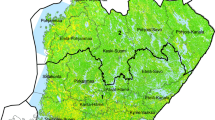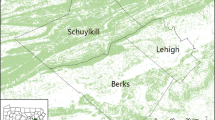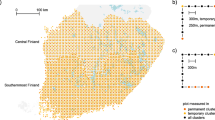Abstract
Many countries have a national forest inventory (NFI) designed to produce statistically sound estimates of forest parameters. However, this type of inventory may not provide reliable results for forest damage which usually affects only small parts of the forest in a country. For this reason, specially designed forest damage inventories are performed in many countries, sometimes in coordination with the NFIs. In this study, we evaluated a new approach for damage inventory where existing NFI data form the basis for two-phase sampling for stratification and remotely sensed auxiliary data are applied for further improvement of precision through post-stratification. We applied Monte Carlo sampling simulation to evaluate different sampling strategies linked to different damage scenarios. The use of existing NFI data in a two-phase sampling for stratification design resulted in a relative efficiency of 50 % or lower, i.e., the variance was at least halved compared to a simple random sample of the same size. With post-stratification based on simulated remotely sensed auxiliary data, there was additional improvement, which depended on the accuracy of the auxiliary data and the properties of the forest damage. In many cases, the relative efficiency was further reduced by as much as one-half. In conclusion, the results show that substantial gains in precision can be obtained by utilizing auxiliary information in forest damage surveys, through two-phase sampling, through post-stratification, and through the combination of these two approaches, i.e., post-stratified two-phase sampling for stratification.






Similar content being viewed by others
References
Anonymous (2007). Swedish Statistical Yearbook of Forestry 2007. In: S. F. Agency (Ed.). Jönköping: Swedish Forestry Agency.
Anonymous (2012). Beredskap vid skador på skog. (in Swedish) Meddelande 2012:3. Jönköping: Swedish Forestry Agency.
Backsen, J. C., & Howell, B. (2013). Comparing aerial detection and photo interpretation for conducting forest health surveys. Western Journal of Applied Forestry, 28(1), 3–8. doi:10.5849/wjaf.12-010.
Bennett, D. D., & Tkacz, B. M. (2008). Forest health monitoring in the United States: a program overview. Australian Forestry, 71(3), 223–228.
Bivand, R., Keitt, T. and Rowlingson, B. (2014). rgdal: bindings for the geospatial data abstraction library. R package version 0.8-16. http://CRAN.R-project.org/package=rgdal.
Carnegie, A. J. (2008). A decade of forest health surveillance in Australia: an overview. [Guest editorial and introduction to special issue]. Australian Forestry, 71(3), 161–163.
Carnegie, A. J., Cant, R. G., & Eldridge, R. H. (2008). Forest health surveillance in New South Wales, Australia. Australian Forestry, 71(3), 164–176.
Coggins, S. B., Coops, N. C., Hilker, T., & Wulder, M. A. (2013). Augmenting forest inventory attributes with geometric optical modelling in support of regional susceptibility assessments to bark beetle infestations. International Journal of Applied Earth Observation and Geoinformation, 21, 444–452. doi:10.1016/j.jag.2012.06.007.
Congalton, R. G., & Green, K. (2009). Assessing the accuracy of remotely sensed data: principles and practices (2nd ed.). Boca Raton: CRC Press.
Dale, V. H., Joyce, L. A., McNulty, S., Neilson, R. P., Ayres, M. P., Flannigan, M. D., et al. (2001). Climate change and forest disturbances: climate change can affect forests by altering the frequency, intensity, duration, and timing of fire, drought, introduced species, insect and pathogen outbreaks, hurricanes, windstorms, ice storms, or landslides. BioScience, 51(9), 723–734. doi:10.1641/0006-3568(2001)051[0723:ccafd]2.0.co;2.
Dowle, M., Short, T., Lianoglou, S., Srinivasan, A. with contributions from Saporta, R. and Antonyan, E. (2014). data.table: extension of data.frame. R package version 1.9.2. http://CRAN.R-project.org/package=data.table
Edgar, C., & Burk, T. (2006). A simulation study to assess the sensitivity of a forest health monitoring network to outbreaks of defoliating insects. Environmental Monitoring and Assessment, 122(1–3), 289–307.
Fassnacht, F. E., Latifi, H., & Koch, B. (2012). An angular vegetation index for imaging spectroscopy data—preliminary results on forest damage detection in the Bavarian National Park, Germany. International Journal of Applied Earth Observation and Geoinformation, 19, 308–321.
Gheysen, T., Brostaux, Y., Hebert, J., Ligot, G., Rondeux, J., & Lejeune, P. (2011). A regional inventory and monitoring setup to evaluate bark peeling damage by red deer (Cervus elaphus) in coniferous plantations in Southern Belgium. Environmental Monitoring and Assessment, 181(1–4), 335–345.
Gregoire, T. G., & Schabenberger, O. (1999). Sampling-skewed biological populations: behavior of confidence intervals for the population total. Ecology, 80(3), 1056–1065.
Guo, Q. H., Kelly, M., Gong, P., & Liu, D. S. (2007). An object-based classification approach in mapping tree mortality using high spatial resolution imagery. Giscience & Remote Sensing, 44(1), 24–47.
Hame, T. (1991). Spectral interpretation of changes in forest using satellite scanner images. Acta Forestalia Fennica, 222, 111.
Heurich, M., Ochs, T., Andresen, T., & Schneider, T. (2010). Object-orientated image analysis for the semi-automatic detection of dead trees following a spruce bark beetle (Ips typographus) outbreak. European Journal of Forest Research, 129(3), 313–324.
Hijmans, R.J. (2014). raster: raster: geographic data analysis and modeling. R package version 2.2–31. http://CRAN.R-project.org/package=raster
Hopkins, P. F., & Abrahamson, L. P. (1984). Scleroderris canker survey using aerial photography. In P. D. Manion (Ed.), Scleroderris canker of conifers (pp. 226–235). Netherlands: Springer.
Kärvemo, S., Van Boeckel, T. P., Gilbert, M., Grégoire, J.-C., & Schroeder, M. (2014). Large-scale risk mapping of an eruptive bark beetle—importance of forest susceptibility and beetle pressure. Forest Ecology and Management, 318, 158–166.
Kautz, M., Schopf, R., & Ohser, J. (2013). The “sun-effect”: microclimatic alterations predispose forest edges to bark beetle infestations. European Journal of Forest Research, 132(3), 453–465.
Leckie, D. G., Cloney, E., & Joyce, S. P. (2005). Automated detection and mapping of crown discolouration caused by jack pine budworm with 2.5m resolution multispectral imagery. International Journal of Applied Earth Observation and Geoinformation, 7(1), 61–77.
Liu, D. S., Kelly, M., & Gong, P. (2006). A spatial-temporal approach to monitoring forest disease spread using multi-temporal high spatial resolution imagery. Remote Sensing of Environment, 101(2), 167–180.
Lucas, S. (2009). Evaluation of damage from the storm Klaus in stands of maritime pine. Foret-Entreprise, 188, 41–45.
Massey, A., Mandallaz, D., & Lanz, A. (2014). Integrating remote sensing and past inventory data under the new annual design of the Swiss National Forest Inventory using three-phase design-based regression estimation. Canadian Journal of Forest Research, 44, 1177–1186.
McRoberts, R. E., Holden, G. R., Nelson, M. D., Liknes, G. C., & Gormanson, D. D. (2005). Using satellite imagery as ancillary data for increasing the precision of estimates for the forest inventory and analysis program of the USDA Forest Service. Canadian Journal of Forest Research-Revue Canadienne De Recherche Forestiere, 35(12), 2968–2980.
Meddens, A. J. H., Hicke, J. A., & Vierling, L. A. (2011). Evaluating the potential of multispectral imagery to map multiple stages of tree mortality. Remote Sensing of Environment, 115(7), 1632–1642.
Næsset, E., Bollandsås, O. M., Gobakken, T., Gregoire, T. G., & Ståhl, G. (2013). Model-assisted estimation of change in forest biomass over an 11 year period in a sample survey supported by airborne LiDAR: a case study with post-stratification to provide “activity data”. Remote Sensing of Environment, 128, 299–314.
Nevalainen, S. (1999). Gremmeniella abietina in Finnish Pinus sylvestris stands in 1986–1992: a study based on the National Forest Inventory. Scandinavian Journal of Forest Research, 14(2), 111–120.
Nevalainen, S., Lindgren, M., Pouttu, A., Heinonen, J., Hongisto, M., & Neuvonen, S. (2010). Extensive tree health monitoring networks are useful in revealing the impacts of widespread biotic damage in boreal forests. Environmental Monitoring and Assessment, 168(1), 159–171.
Nilsson, A., Folving, S., Kennedy, P., Puumalainen, J., Chirici, G., Corona, P., et al. (2003). Combining remote sensing and field data for deriving unbiased estimates of forest parameters over large regions (Vol. 76, Advances in Forest Inventory for Sustainable Forest Management and Biodiversity Monitoring).
Nilsson, M., Holm, S., Wallerman, J., Reese, H., Olsson, H. (2009). Estimating annual cuttings using multi-temporal satellite data and field data from the Swedish NFI. International Journal Of Remote Sensing, 30(19), 5109–5116.
Perpinan Lamiguero, O. and Hijmans, R. (2014), rasterVis. R package version 0.31. doi:10.5281/zenodo.11390
R Core Team (2014). R: A language and environment for statistical computing. R Foundation for Statistical Computing, Vienna, Austria. http://www.R-project.org/. Accessed 3 November 2014.
Reese, H., Nilsson, M., Granqvist-Pahlén, T., Hagner, O., Joyce, S., Tingelöf, U., et al. (2003). Countrywide estimates of forest variables using satellite data and field data from the National Forest Inventory. AMBIO: A Journal of the Human Environment, 32(8), 542–548.
Reese, H., Granqvist Pahlén, T., Egberth, M., Nilsson, M., & Olsson, H. (2005). Automated estimation of forest parameters for Sweden using Landsat data and the kNN algorithm. St. Petersburg: Proceedings for the 31st International Symposium on Remote Sensing of the Environment.
Samalens, J. C., Rossi, J. P., Guyon, D., Van Halder, I., Menassieu, P., Piou, D., et al. (2007). Adaptive roadside sampling for bark beetle damage assessment. Forest Ecology and Management, 253(1–3), 177–187.
Särndal, C.-E., Swensson, B., & Wretman, J. H. (1992). Model assisted survey sampling. New York: Springer.
Schelhaas, M.-J., Nabuurs, G.-J., & Schuck, A. (2003). Natural disturbances in the European forests in the 19th and 20th centuries. Global Change Biology, 9(11), 1620–1633.
Schroeder, L. M., & Lindelow, A. (2002). Attacks on living spruce trees by the bark beetle Ips typographus (Col. Scolytidae) following a storm-felling: a comparison between stands with and without removal of wind-felled trees. Agricultural and Forest Entomology, 4(1), 47–56.
Seidl, R., Schelhaas, M.-J., & Lexer, M. J. (2011). Unraveling the drivers of intensifying forest disturbance regimes in Europe. Global Change Biology, 17(9), 2842–2852.
Swedish Target-tailored Forest Damage Inventory (2015). http://www.slu.se/en/departments/forest-resource-management/environment/target-tailored-forest-damage-inventories/. Last accessed 6 Aug 2015
Tomppo, E., Olsson, H., Ståhl, G., Nilsson, M., Hagner, O., & Katila, M. (2008). Combining national forest inventory field plots and remote sensing data for forest databases. Remote Sensing of Environment, 112(5), 1982–1999.
Wallin, M. (2004). Satellitbildsanalys av gremmeniellaskador med skogsvårdsorganisationens system (in Swedish)(p.19). [Analysis of gremmeniella damage through analysis of Satellite imagery using the forest agencys system]. Work report 102, Department of Forest Resource Management, SLU, Umeå, Sweden.
Wulder, M. A., & Franklin, S. E. (2007). Understanding forest disturbance and spatial pattern: remote sensing and GIS approaches. Boca Raton: CRC Press.
Wulder, M. A., Dymond, C. C., White, J. C., Erickson, B., Safranyik, L., & Wilson, B. (2006a). Detection, mapping, and monitoring of the mountain pine beetle. The mountain pine beetle: a synthesis of biology, management, and impacts on lodgepole pine. 123–154.
Wulder, M. A., Dymond, C. C., White, J. C., Leckie, D. G., & Carroll, A. L. (2006a). Surveying mountain pine beetle damage of forests: a review of remote sensing opportunities. Forest Ecology and Management, 221(1–3), 27–41.
Wulff, S., Hansson, P., & Witzell, J. (2006). The applicability of national forest inventories for estimating forest damage outbreaks—experiences from a Gremmeniella outbreak in Sweden. Canadian Journal of Forest Research-Revue Canadienne De Recherche Forestiere, 36(10), 2605–2613.
Wulff, S., Lindelöw, Å., Lundin, L., Hansson, P., Axelsson, A.-L., Barklund, P., et al. (2012). Adapting forest health assessments to changing perspectives on threats—a case example from Sweden. Environmental Monitoring and Assessment, 184(4), 2453–2464.
Wulff, S., Roberge, C., Ringvall, A. H., Holm, S., & Stahl, G. (2013). On the possibility to monitor and assess forest damage within large scale monitoring programmes—a simulation study. Silva Fennica, 47(3), 1000-article id 1000.
Acknowledgments
We thank two anonymous reviewers for their constructive comments on the manuscript. The authors also thank Anna Hedström-Ringvall for starting this project and for all her help. We also wish to thank the staff of the Swedish NFI and the TFDI for their valuable work. Cornelia Roberge was supported by grant 2008-546 from the Swedish Research Council Formas to Anna Hedström-Ringvall.
Author information
Authors and Affiliations
Corresponding author
Appendix
Appendix
For simulation of GRELOC damage population, we let the frequency of damage-affected grid cells decrease away from the epicenter using the following functions:
where
where wx = 1,600,000, xm = ym = 1.5, pov = pns = 0.99, and
where wy = 7,070,000.
Equation 13 returns values from 0 to 1, and we multiplied it by the pine volume share in areas with 0.6 or more pine volume. x and y are independent. α = −10 and β = 20 in Eq. 6 (F(x)). We drew a random number r ∈ U(0, 1) for each grid cell, and if F(f(x, y) * ptall) − r > 0, the grid cell was considered affected by the damage.
Rights and permissions
About this article
Cite this article
Roberge, C., Wulff, S., Reese, H. et al. Improving the precision of sample-based forest damage inventories through two-phase sampling and post-stratification using remotely sensed auxiliary information. Environ Monit Assess 188, 213 (2016). https://doi.org/10.1007/s10661-016-5208-4
Received:
Accepted:
Published:
DOI: https://doi.org/10.1007/s10661-016-5208-4




